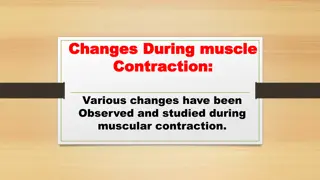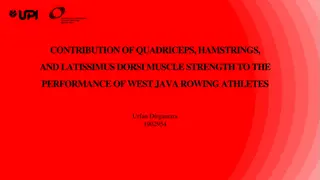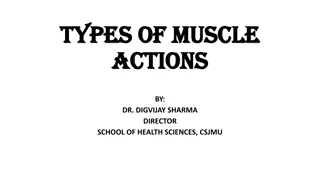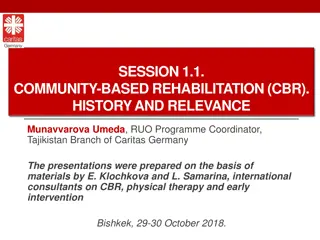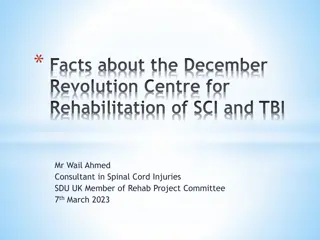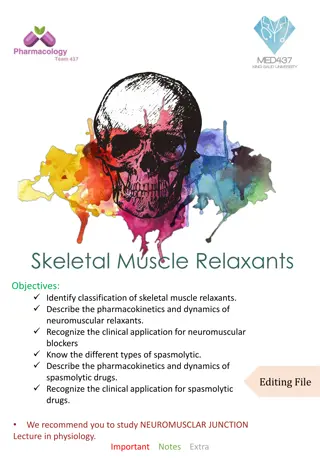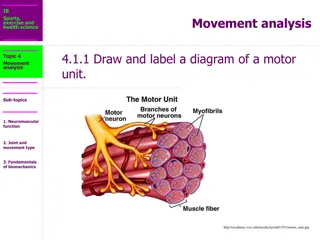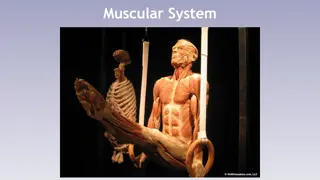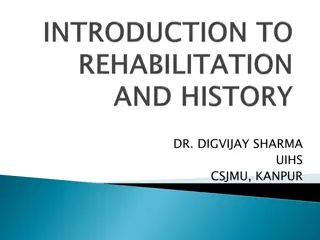Importance of Manual Muscle Testing in Rehabilitation
The assessment of muscle function is crucial in various medical exams, showing correlations with quality of life, work productivity, and aging-related issues. Manual muscle testing is commonly used by healthcare professionals to evaluate muscle strength and guide treatment plans. Assessing muscle function helps in diagnosis, monitoring progress, predicting outcomes, and determining the need for interventions. Muscle strength is a key component of overall muscle performance and is a primary focus when evaluating muscle function in clinical settings.
Download Presentation

Please find below an Image/Link to download the presentation.
The content on the website is provided AS IS for your information and personal use only. It may not be sold, licensed, or shared on other websites without obtaining consent from the author. Download presentation by click this link. If you encounter any issues during the download, it is possible that the publisher has removed the file from their server.
E N D
Presentation Transcript
Examination Methods in Rehabilitation, 5.10.2020 Manual muscle testing Introduction (1) Souvisej c obr zek Mgr. Veronika Mrkvicov (physiotherapist)
Content Muscle strength Assessing muscle strength Manual muscle test
Vsledek obrzku pro manual muscle testing V sledek obr zku pro manual muscle testing Souvisej c obr zek V sledek obr zku pro manual muscle testing Souvisej c obr zek V sledek obr zku pro manual muscle testing
Introduction The measurement of muscle function is an essential component of many neurological and physical exams V sledek obr zku pro elderly quality of life Muscle strength correlates to : function work productivity general quality of life Muscle function becomes compromised: as we age when associated with a skeletal impairment as a secondary consequence of many disease processes
Assessing muscle function It is an important clinical skill that is routinely used by: Neurologists Orthopedists General practitioners Occupational and physical therapists V sledek obr zku pro manual muscle testing
Assessing muscle function Evaluation of muscle strength is used for: Diagnostic, differential diagnosis Examine the improvement or deterioration of a patient s status over time Predictive or prognostic tool Determine the extent of strength loss Outcome measures in clinical research Determine the need for compensatory measures or assistive devices Helps in the formulation of the treatment plan Evaluates the effectiveness of treatment
Assessing muscle function There are several components of muscle performance: Muscle performance Muscle strength Instantaneous muscle power Muscle endurance Of these performance indicators, muscle strength is the one most commonly measured when assessing the muscle function
Components of muscle performance 1. Muscle performance the capacity of a muscle to do work V sledek obr zku pro muscle performance
Components of muscle performance 2. Muscle strength the force exerted by a muscle or group of muscles to overcome a resistance in one maximal effort V sledek obr zku pro muscle strength
Components of muscle performance 3. Instantaneous muscle power the mechanical power produced by the muscle (muscle force times muscle velocity)
Components of muscle performance 4. Muscle endurance the ability to contract a muscle repeatedly over time V sledek obr zku pro muscle endurance
Assessing muscle strength In assessing muscle strength, the conditions under which the muscle contracts must be specified so that the muscle test data can be interpreted properly The following conditions are relevant: Isometric contraction Isotonic contraction Isokinetic contraction
Assessing muscle strength 1. Isometric contraction the muscle contracts while at a fixed length 2. Isotonic contraction the muscle contracts while working against a fixed load (eg. a hanging weight) 3. Isokinetic contraction the muscle contracts while moving at a constant velocity (generally, isokinetic contractions are only possible with the limb strapped into a special machine that imposes the constant velocity condition)
Assessing muscle strength Eccentric contraction the muscle contracts against a load that is greater than the force produced by the muscle so that the muscle lengthens while contracting Concentric contraction the muscle contracts against a load that is less than the force produced by the muscle so that the muscle shortens while contracting
Muscle weakness It means any reduction of the normal ability of the muscle to generate force V sledek obr zku pro muscle weakness Causes: Muscle strain Pain, reflex inhibition Nerve root lesion Tendon pathology, avulsion, rupture Prolonged disuse/immobilization Psychological overlay
Muscles work in pairs Muscles usually work in pairs or groups (e.g. the biceps flexes the elbow and the triceps extends it) it is called antagonistic muscle action The working muscle is called the prime mover or agonist. The relaxing muscle is the antagonist (e.g. quadriceps and hamstrings) The prime mover is helped by other muscles called synergists. These contract at the same time as the prime mover. They hold the body in position so that the prime mover can work smoothly
Muscles Agonist muscles cause a movement to occur through their own contraction Antagonist muscles oppose a specific movement. This controls a motion, slows it down, and returns a limb to its initial position Synergist muscles performs, or helps perform, the same set of joint motion as the agonists. Synergists muscles act on movable joints. Synergists are sometimes referred to as "neutralizers" because they help cancel out, or neutralize, extra motion from the agonists to make sure that the force generated works within the desired plane of motion
Muscles Neutralizer Action A muscle that fixes or holds a bone so that the agonist can carry out the intended movement is said to have a neutralising action
Muscle function The biceps brachii flex the lower arm. The brachoradialis, in the forearm, and brachialis, located deep to the biceps in the upper arm, are both synergists that aid in this motion
Definition Manual muscle testing (MMT) is an attempt to determine a patient's ability to voluntarily contract a specific muscle V sledek obr zku pro muscle weakness (Keep in mind that this does not provide information on the patient's ability to use the muscle in daily activities, or if the muscle interacts with other muscle around it in a synergistic pattern)
MMT it is the simplest and most common method of assessing muscle strength a procedure for evaluating strength and function of an individual muscle or a muscle group in which the patient voluntarily contracts the muscle against gravity load or manual resistance quick, efficient, and easy to learn, however, it requires total cooperation from the patient and learned response levels by the assessor
MMT The procedures for conducting the MMT have been standardized to assure, as much as possible, that results from the test will be reliable The specific muscle or muscle group must be determined and the examiner must be aware of, and control for, common substitution patterns where the patient voluntarily or involuntarily uses a different muscle to compensate for a weak muscle being tested
MMT To conduct a MMT, the patient is positioned in a posture appropriate for the muscle being tested, which generally entails isolating the muscle and positioning so that the muscle works against gravity The body part proximal to the joint acted on by the muscle is stabilized A screening test is performed by asking the patient to move the body part through the full available range of motion (ROM) The main test is then performed either unloaded, against a gravity load, or against manual resistance, and a grade is assigned to indicate muscle strength
Souvisejc obrzek Purpose of MMT MMT is indicated in any patient with suspected or actual impaired muscle performance, including strength, power, or endurance V sledek obr zku pro muscle hypotrophy Identification of specific impaired muscles or muscle groups provides information for proper treatment
Precautions It is important to determine the patient's ability to resist the force to be applied Proper positioning is important, as is instruction in breathing techniques (avoid the Val Salva) Remember to assess surrounding area for ability to sustain muscle test In the case of a recent fracture, post-surgical, or other tissue healing, consider post-poning muscle test
Note: Always tell your client about what procedure you are going to perform and what you are going to obtain from that procedure Remember to check the uninvolved side first and be consistent on where you apply the resistance Also, instruct your client not to hold his or her breath as you apply force or resistance
Note: Muscle origin, insertion and action Function of participating muscles Patterns of substitution Ability to detect contractile activity Ability to palpate muscle or tendon Ability to detect atrophy Recognize abnormal position or movement
MMT - grading Manual grading of muscle strength is based on: palpation or observation of muscle contraction ability to move the limb through its available ROM against or without gravity ability to move the limb through its ROM against manual resistance by the examiner Manual resistance is applied by the examiner using one hand with the other hand stabilizing the joint Exact locations for applying resistive force are specified and must be followed exactly to obtain accurate MMT results
MMT - grading A slow, repeatable velocity is used to take the limb through its ROM, applying a resistive force just under the force that stops motion The instructions to the patient are to use all of their strength to move the limb as far as possible against the resistance For weaker muscles that can move the limb, but not against gravity, the patient is repositioned so that the motion is done in the horizontal plane with no gravity
MMT - grading The assignment of scores is based on clinical judgment and the experience of the examiner The amount of resistance (moderate, maximal) applied by the examiner is also based on clinical experience and is adjusted to match the muscle being tested as well as the patient s age, gender and/or body type
MMT - grading While the MMT is the most widely used method to assess muscle function, its reliability and accuracy are questionable The MMT scores are least accurate for higher force levels Interrater reliability for MMT is not high, suggesting that the same examiner should perform multiple tests on one subject or across subjects All tests based on voluntary activation of a muscle are prone to artifact because of patient motivation and examiner encouragement
Grade 5 (Normal; 100%) The patient or subject can complete the whole range of motion (movement) against gravity with maximum resistance applied by the therapist at end-of-range
Grade 4 (Good;75%) The subject can complete the whole range of motion against gravity with moderate resistance applied by the physical therapist (PT) at end-range. Testing the uninvolved limb should always be considered to know whether you are applying too much force on the involved limb or not
Grade 3+ (Fair+) The patient can complete the motion against gravity with minimal resistance applied by the examiner at end-range
Grade 3 (Fair;50%) The patient can only complete the range of motion against gravity. When external force is applied by the PT, the patient gives way
Grade 2+ (Poor +) Patient can move his or her joint at a certain range but cannot complete the motion against gravity. When gravity is eliminated, such as performing the motion in side-lying, your client can perform the movement at full range of motion with ease. However, muscles being tested give way immediately when you apply some resistance
Grade 2 (Poor;25%) Patient cannot perform the movement against gravity. But patient can do complete range of motion when pull of gravity is eliminated. No resistance is applied.
Grade 2 - (Poor -) Initiation of movement can be done only as gravity is eliminated. That is, only a partial movement is observed. Here, full range cannot be completed.
Grade 1 (Trace) Patient is not able to move the joint even with gravity eliminated. However, closer examination by the therapist would reveal slight muscle contraction through palpation.
Grade 0 (Zero; No trace) No contraction is noticed, even with physical therapist's palpation (touch).
Grading 5 4+ 4 4- 3+ 3 3- 2+ 2 2- 1 0 Normal subject completes ROM against gravity with maximal resistance Good Plus completes ROM against gravity with moderate-maximal resistance Good completes ROM against gravity with moderate resistance Good Minus completes ROM against gravity with minimal-moderate resistance Fair Plus completes ROM against gravity with only minimal resistance Fair completes ROM against gravity without manual resistance Fair Minus does not complete the range of motion against gravity, but does complete more than half of the range Poor Plus is able to initiate movement against gravity Poor completes range of motion with gravity eliminated Poor Minus does not complete ROM in a gravity eliminated position Trace muscle contraction can be palpated, but no joint movement Zero patient demonstrates no palpable muscle contraction
General procedure Basic consideration: Observation Palpation Positioning Stabilization Resistance Validity and reliability V sledek obr zku pro providing manual muscle testing
1. Observation and palpation Observe the size and contour of muscles Palpate contractile tissues
2. Position Patient The patient and the part to be tested should be positioned comfortably on a firm surface in the correct testing position The correct testing position ensures that the muscle fibers to be tested are correctly aligned The patient is properly draped so that the involved body part is exposed as necessary
3. Stabilization Stabilization, which helps to prevent substitute movements and adds validity to the muscle test, can be provided manually (or through the use of an external support such as a belt) The stabilization is applied to the proximal segment using counter pressure to the resistance
4. Active Range of Motion The patient moves through the test the body segment actively against gravity The clinician palpates the muscle for activity and also notes any adaptive shortening (slight to moderate loss of motion), substitutions or trick movements (weakness or instability), or contractures (marked loss of motion) The joint is then returned to the start position If the patient is unable to perform the muscle action against gravity, the patient is positioned in the gravity-minimized position Generally speaking, testing the muscle in the transverse plane can minimize the effects of gravity
Validity and Reliability Patient Factors Age Gender Pain Fatigue Lower motor neuron disease Spasticity Therapist factors Experience Manner and content of instructions Interaction Environmental factors Temperature Distractions Other factors Muscle factors Psychological factors Methodological factors
Test The test should be completed on the uninvolved side first to find out normal strength before being repeated on the involved side Then the patient is instructed to complete the test movement on the involved side The clinician alerts the patient that resistance will be applied and then applies resistance in the appropriate direction and in a smooth and gradual fashion
Test The proper location for the application of resistance is as far distal as possible from the axis of movement on the moving segment without crossing another joint Resistance should never cross an intervening joint unless the integrity of the joint has been assessed as normal The resistance is applied in a direction opposite the muscle's rotary component and at right angles to the long axis of the segment (opposite the line of the pull of the muscle fibers)













